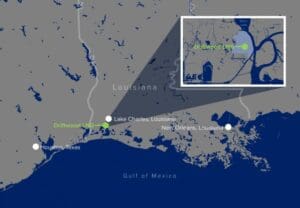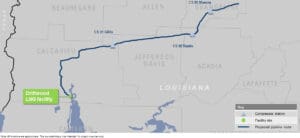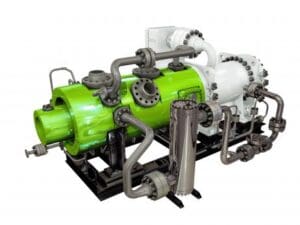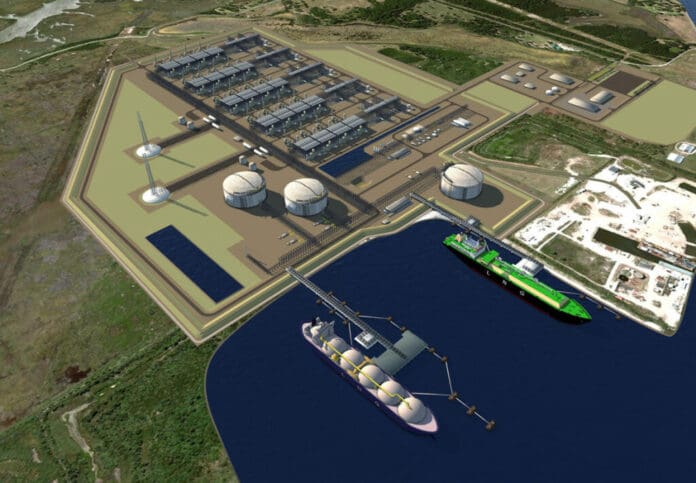Tellurian Inc. (Tellurian) announced that Tellurian Production LLC (TPC), a wholly owned subsidiary of Tellurian, has agreed to purchase US$125 million of natural gas production assets located in the Haynesville shale from privately held EnSight IV Energy Partners, LLC and EnSight Haynesville Partners, LLC (collectively EnSight). Tellurian said it is funding the project with cash. Effective August 1, 2022, the transaction is expected to close in Q3 2022.
Details Of The Deal
EnSight’s assets include roughly 45 MMscf/d (1.27 × 106 m3/d) of natural gas; approximately 5000 net acres (2023 ha) in the core of the Haynesville shale in DeSoto, Bossier, Caddo, and Webster Parishes, Louisiana; 44 producing wells and five wells in progress at transaction close; and proved reserves of approximately 108 Bscf (3.06 × 109 m3) of natural gas.
Tellurian believes the assets achieve a relatively low cost of production and are free cash flow (FCF) positive. However, it is unclear what the natural gas price needs to be to achieve positive FCF. Given multidecade high natural gas prices, virtually all plays are FCF positive right now. High natural gas prices increase the return on invested capital for liquefied natural gas (LNG) megaprojects by boosting margins and allowing projects with higher costs of production to be financially feasible. Tellurian forecasts 2023 earnings before interest, taxes, depreciation, and amortization (EBITDA) of US$90 million to US$120 million from the project. If its forecast is correct, Tellurian is getting a bargain bin price for the Haynesville shale acreage. “Tellurian continues to focus on two critical pathways: progressing Driftwood LNG and continuing to increase our upstream footprint,” said Tellurian President and CEO Octávio Simões. “This transaction grows our 2023 estimated natural gas production by 30%, increases upstream asset-level EBITDA by 25%, and expands upon our existing platform.”
Tellurian has identified 30 gross drilling locations on the EnSight acreage and plans to maintain a one-rig drilling program through Q4 2022. All told, TPC expects its 2022 proforma net production to be around 140 MMscf/d (3.96 × 106 m3/d) of natural gas, more than triple the 39 MMscf/d (1.1 × 106 m3/d) of natural gas it produced in 2021. In 2023, TPC said it was boosting its drilling program to two rigs and expects full-year production to be 350 MMscf/d (9.9 ×` 106 m3/d). TPC’s total Haynesville shale acreage is now 20,000 net acres (8094 ha), approximately 275 gross drilling locations, and 2 Tscf (5.6 × 1010 m3) of net resource. “We have been diligently growing our natural gas production and reserves in the Haynesville,” said TPC President John Howie. “These assets provide Tellurian with both cash flow and a physical hedge for Driftwood LNG. The EnSight asset is a great fit with Tellurian’s existing position in the Haynesville shale and allows us to step into an ongoing development program and bring online significant additional natural gas volumes in Q4 2022.”
Acquiring Upstream Assets For Driftwood LNG
Securing production is essential for Tellurian to make sure it has a steady supply stream to fuel its mammoth LNG export terminal. After years of project delays and setbacks during the worst of the COVID-19 pandemic, Tellurian announced in February that it was ready to move forward with construction of its US$16.8 billion Driftwood LNG plant in Louisiana. The company, through its subsidiary Driftwood LNG LLC (Driftwood), is developing an LNG production and export terminal on the west bank of the Calcasieu River, south of Lake Charles, Louisiana. Once complete, the terminal will be able to export up to 27.6 MTPA of LNG to customers worldwide.

In its July investor presentation, Tellurian announced that it completed owner’s projects on schedule in March 2022 and issued a limited notice to Bechtel in April 2022 to begin construction with first delivery of LNG taking place in 2026. The company had previously announced it hoped to achieve commerciality in Q1 2022. According to Tellurian, Bechtel is currently onsite performing demolition and site clearing. Its piling program commenced in July.
Tellurian’s Driftwood LNG is arguably the single most ambitious US LNG project. Yet it has undergone a fair share of changes in recent months. Earlier this year, Tellurian reported that Phase 1 would consist of three plants with a combined capacity of 16.5 MTPA and an expected cost of US$16.8 billion. Under this commercial framework, Driftwood Phase 1 was expected to generate around US$3.7 billion in EBITDA per year. Plans to add two more plants would bring the total project’s capacity to its full scale of 27.6 MTPA for a total cost of US$30 billion. All told, the facility would have 20 LNG trains and at least 24.9 MMscf (705,000 m3) of storage capacity.
However, in its July investor presentation, Tellurian said that Driftwood LNG Phase 1 would now consist of two plants, 11 MTPA of total capacity, and development costs of US$12.8 billion, with US$8.5 billion of Phase 1 costs coming from the LNG terminal. Assuming an LNG sales price of US$85/barrel of Brent crude oil, which converts roughly to US$14/Btu based on Japan/Korea Marker (JKM) pricing, Tellurian is penciling in an LNG sales price of US$12/MMBtu once factoring in transportation costs. Gas sourcing is expected to cost US$3/MMBtu, while liquefaction and transport is expected to cost US$1/MMBtu. Add it all up, and Tellurian is expecting operating cash flow of $8/MMBtu, or a 57% operating cash flow margin. For the full year, that would give Phase 1 US$4 billion in operating cash flow, which would be used to fund plants three, four, and five. Excess cash would allow Tellurian to avoid relying heavily on debt for its full-scale project. All told, the full development is expected to keep the same margin of US$8/MMBtu based on the US$14/MMBtu JKM price. But thanks to scale, operating cash flow would rise to US$11 billion per year.
It’s a good plan, but Tellurian’s current upstream production leaves it woefully unprepared to supply Driftwood LNG with the feed gas it needs to be ready for Phase 1 by 2026. For context, Driftwood’s Phase 1 requires around 1.507 Bscf/d (42.7 × 106 m3/d) of feed gas, which is 430% more than its expected 2023 production and more than 10 times its expected 2022 production. Tellurian does have around 2 Bscf (5.6 × 107 m3) of proven reserves across its asset portfolio, but even if all those reserves magically came on stream tomorrow, they would run dry in less than four years based on Phase 1’s capacity requirements. To understand the sheer scale of Phase 1 of the Driftwood LNG project, consider that the EnSight deal’s 45 MMscf/d supplies around just 3% of Driftwood’s feed gas requirement. In sum, Tellurian will need to secure a lot more natural gas production assets to reliably support Driftwood Phase 1 and future expansions.
Zooming Out On The Big Picture
The Driftwood LNG plant will be comprised of a natural gas liquefaction and export facility and a 96-mile (154-km) pipeline that will deliver natural gas to the facility at an average of 4 Bscf/d (1.1 × 108 m3/d).

Assuming Tellurian can get the gas supply it needs for Phase 1 within the next three years, it will still need additional partners for Driftwood LNG’s full development. The project’s location is within striking distance of several major natural gas plays, including the Haynesville shale, SCOOP/STACK in Oklahoma, Permian basin, and the Marcellus-Utica basins. New interstate pipelines are in the works to help lower transport costs and encourage increased natural gas production out of these key regions.
Driftwood LNG plans include the construction of three new compressor stations that will utilize gas turbine-driven centrifugal compressors to boost pipeline pressure. Compressor Station 1 (Gillis Station) will be located in Jefferson Davis Parish and will include five natural gas-powered compressor turbines with a total rated capacity of approximately 150,000 hp (111,900 kW). Compressor Station 2 (Basile Station) will be located in Acadia Parish and include three natural gas-powered compressor turbines with a total rated capacity of approximately 78,500 hp (58,561 kW). Compressor Station 3 (Mamou Station) will be located in Evangeline Parish and include two natural gas-powered compressor turbines with a total rated capacity of approximately 41,000 hp (30,586 kW).
Three Phases Of Pipeline Construction
Phase 1 pipeline construction consists of the following:
- 8 miles (87.7 km) of 48-in. (1219-mm) pipeline, extending from the Driftwood LNG Project in Calcasieu Parish to a proposed interconnect with Tennessee Gas Pipeline (Tennessee interconnect) near Kinder, Louisiana.
- 4 miles (5.4 km) of 20-in. (508-mm) pipeline lateral, installed parallel and adjacent to the 48-in. mainline between milepost 36.5 and 39.9 in Calcasieu and Jefferson Davis Parishes.
- The Gillis Compressor Station.
- One delivery meter station and five receipt meter stations in Calcasieu and Jefferson Davis Parishes.
Phase 2 pipeline construction consists of the following:
- 3 miles (37.5 km) of 48-in. pipeline, extending from the Tennessee interconnect to a proposed interconnect with ANR Pipeline (ANR interconnect) near Eunice, Louisiana.
- 2 miles (8.3 km) of 42-in. (1066-mm) pipeline, extending from the ANR interconnect to a proposed interconnect with Texas Eastern Transmission (Texas Eastern interconnect) near Egan, Louisiana.
- The Basile Compressor Station.
- Six receipt meter stations in Acadia and Evangeline Parishes.
Phase 3 pipeline construction consists of the following:
- 4 miles (8.6 km) of 42-in. pipeline, extending from the Texas Eastern interconnect to Driftwood Pipeline’s new Mamou Compressor Station near Mamou, Louisiana.
- 3 miles (18.1 km) of 36-in. (914-mm) pipeline, extending from the Mamou Compressor Station to a proposed interconnect with Columbia Gulf Transmission near Ville Platte, Louisiana.
- The Mamou Compressor Station.
- Two additional 30,000-hp (22,380-kW) natural gas-fired compressor turbines installed at Gillis Compressor Station, for a total of 150,000 hp at the station.
- Two additional 30,000-hp natural gas-fired compressor turbines installed at Basile Compressor Station, for a total of 78,500 hp at the station.
- Two receipt meter stations in Evangeline Parish.
The production and export terminal will consist of five identical LNG plants — two plants for Phase 1 and then most likely one plant per phase after that. Each plant will consist of one gas pretreatment unit (acid gas removal unit, dehydration unit, and mercury removal unit), one condensate stabilization unit, and four heavy hydrocarbon removal and liquefaction units.
LNG will be stored at the site in three full-containment LNG storage tanks. The marine facilities will include three berths designed to allow the safe berthing and un-berthing of three LNG ships up to 7.6 MMscf (216,000 m3) each. The marine facilities will have cryogenic piping and loading arms for loading LNG ships. At each berth, a vapor management system, including a vapor arm, will be installed to transfer boil off gas (BOG) from the LNG ship to the BOG handling system. The LNG storage tanks will be fitted with pumps to transfer LNG to ships at each berth at a loading rate of up to 423,776 scf (12,000 m3) per hour, per ship. Two berths will have the capability to load LNG simultaneously. At full capacity, the facility will load a ship a day or approximately 365 ships per year.
Contracts And Financing
Tellurian has yet to secure financing for the entirety of the Driftwood LNG project. However, it has contracted a total of 9 MTPA worth of sale and purchase agreements (SPAs), with the final 2 MTPA of Phase 1 being retained by Tellurian as carried volumes. Put another way, Phase 1 is sold out.
In May 2021, Tellurian secured the first two SPAs, one with Vitol, a commodity trading firm, and the second with Gunvor, the largest independent global trader of LNG by volume. Tellurian then secured a third SPA with Shell in July 2021. Each SPA is for 3 MTPA of LNG over a 10-year period. Combined, the three SPAs are expected to generate annual revenue of US$1.8 billion and annual EBITDA of just under US$1 billion.
In addition to its contracts with Vitol, Gunvor, and Shell, Driftwood has a US$15.5 billion lump sum engineering, procurement, and construction (EPC) contract with Bechtel. Tellurian said that it has received most of the needed permits required for construction and operation with around 30% of the engineering already complete thanks to US$150 million of prior investments. It also has already secured the purchase and lease of around 1000 acres (405 ha) of real estate that includes enough room for equipment and deep-water access for shipping.
In June, Tellurian announced the execution of definitive agreements to sell US$500 million principal amount of senior secured convertible notes, subject to customary closing conditions. The notes will bear interest at 6.0% per annum, expiring May 1, 2025, and will be convertible into shares of Tellurian common stock at an initial conversion price of US$5.724 per share, subject to customary adjustments. The price of Tellurian stock as of the time of this writing is roughly US$3.50 per share.
An Integrated Business Model
Tellurian’s high-risk/high-reward business plan hinges on the seamless integration of several moving parts, as well as high LNG prices and demand. Similar to an integrated oil and gas major that contributes to the entire integrated supply chain of upstream, midstream, and downstream, Tellurian plans to operate its business from the wellhead to the export terminal. It will source upstream gas production from the Haynesville Basin in East Texas and Northwest Louisiana, which will then be transported by the Driftwood pipeline to the Driftwood LNG export terminal and liquefaction facility in southwest Louisiana.
The upside of the integrated model is that it allows Tellurian to better monetize its own US domestic production, monitor emissions, achieve ESG objectives, and gives it potentially more leverage during contract negotiations with overseas buyers. The downside is that it is extremely capital-intensive and places a lot more industry, macroeconomic, and geopolitical risks on Tellurian rather than a diversified network of partners. Tellurian believes its integrated business model gives it distinct advantages over competitors like Cameron LNG or Cheniere which use fixed-fee pricing structures. Tellurian’s pricing model relies on what is called destination market pricing or market-index pricing, which offers more upside than fixed-fee contracts but is prone to market risk.
LNG Supply Deficit
In its July investor presentation, Tellurian cited data that indicated LNG demand has grown by around 7% annually over the last five years. Yet years of underinvestment paired with disruptions due to the COVID-19 pandemic left the market undersupplied heading into the geopolitical crisis in Ukraine. Tellurian estimates that 20 Bscf/d (5.6 x 108 m3/d) of natural gas, or 152 MTPA, will need to be replaced if importers want to distance themselves from Russian supply. That equates to 35% of the world’s LNG demand. Between 2021 and 2030, Tellurian estimates that LNG demand will grow by 132 MTPA plus 66 MTPA of incremental LNG required by Europe without Russian imports. However, the company identified just 115 MTPA of supply growth based on projects that have reached final investment decision (FID), producing a decade-long shortfall of 83 MTPA.
A consequence of an undersupply of natural gas is that importing nations will result to dirtier fuel sources in a pinch even to the detriment of the environment. We’re already seeing this dynamic play out on the global stage. Germany, the largest importer of Russian gas, is investing in more than 30 MTPA of LNG regasification capacity and accelerating its hydrogen investments to chart a path toward independence from Russian gas. In the meantime, Europe’s largest economy has been left with few options other than to burn wood and reopen its coal plants to build energy reserves in time for the winter.
Sustainability In Mind
LNG is a better alternative than most fossil fuels. But too much LNG without renewable energy investment is unsustainable. However, there are ways to construct cleaner LNG export terminals. In June, Tellurian awarded Baker Hughes with a contract to provide its electric-powered Integrated Compressor Line (ICL) technology and turbomachinery equipment for Lines 200 and 300, a natural gas transmission project, proposed to be in Beauregard and Calcasieu Parishes, in southwest Louisiana. “We anticipate the project will supply upwards of 5.5 Bscf/d [155.74 × 106 m3/d] of natural gas, with virtually no emissions,” said Joey Mahmoud, president of Tellurian Pipelines. “Tellurian is doing its part by making this initial US$240 million pipeline investment as part of the broader Driftwood Pipeline system which will provide enhanced supply reliability to meet the area’s projected industrial growth in a cleaner, more sustainable manner.”

Baker Hughes’ ICL is a compact zero-emissions system that features a motor and compressor that are directly flanged and fully integrated in a single-sealed casing with no alignment needed. Tellurian is using the ICL for pipeline compression, but applications for the ICL also include gas storage, gas gathering, small-scale LNG, and onshore and offshore associated gas compression.
According to Baker Hughes, the integrated electric motor compressor is zero emissions because there is no oil lubrication, venting, or seal leakage thanks to magnetic bearings for frictionless shaft support that eliminate lubricant and minimize maintenance. The ICL has a discharge pressure up to 5076 psi (350 bar), inlet flow range of 17,657 scf to 1.24 MMscf (500 to 35,000 m3) per hour, a maximum speed of 15,500 rpm at less than 1 MW and 30,000 rpm greater than 1 MW. Baker Hughes said that the compressor has stable efficiency over a wide operating range of 35% to 105% of nominal speed compared to 70% to 105% for typical compressors.
The Tellurian partnership with Baker Hughes marks the first installation of ICL decarbonization technology for pipeline compression in North America. However, Baker Hughes has installed and deployed more than 50 ICL units for pipeline and offshore applications mainly in Europe. According to Tellurian, the project will initially include four 19-MW ICL compressors and other turbomachinery equipment for a total of four compressor trains, as well as a LM6000PF+ gas turbine for backup power for the initial phase of the pipeline project at Driftwood’s Indian Bayou Compressor Station.
The ICL product and others like it have received increased focus at Baker Hughes thanks to the company’s recently announced ESG goals. The company has already reduced its Scope 1 and Scope 2 emissions by 15% compared to 2019 and plans to reduce its emissions by 50% by 2030 and become net-zero by 2050. Baker Hughes generates more than 20% of its electricity from renewable and zero-carbon sources.
The World Needs More LNG
In past years, industry talk around large-scale LNG export terminals usually centered around buyer profiles and whether importing nations had the infrastructure and funding needed to support the projects. Today, the demand side seems stronger than ever. Now, the biggest unknows are the speeds at which the projects can come online, and if that pace can match the ability for importers to construct their terminals, storage facilities, and associated infrastructure.
Tellurian’s Phase 1 of its Driftwood LNG project is already sold out despite being more than three years from its start date. Similarly, QatarEnergy had no trouble securing funding for its 32-MTPA North Field Expansion East (NFEE) project. Instead of relying on debt, QatarEnergy is funding the US$30 billion project mostly in house plus equity stakes from TotalEnergies, ExxonMobil, Shell, ConocoPhillips, and Eni. Combined, the equity stakes amount to a 25% share of the project, giving QatarEnergy majority ownership and serving as operator of the project.
For the energy sector as a whole, the biggest unknown for the next five years is how the status of Russian exports and global geopolitical tensions will tip the balance of the global energy mix. If Europe refuses to import Russian gas, that changes everything. If China and other large importers turn a blind eye to Moscow’s aggression, then they would likely be able to get Russian gas at a steep discount, which would impact exports from the United States, Qatar, and Australia.
No matter the unknowns, there is no denying that the world needs more LNG. Renewable investment is on the rise and should continue to emerge as the best long-term solution. However, to prevent reliance on coal and for the sake of energy security, LNG continues to shine as a reliable bridge fuel with a lower-carbon intensity than oil and coal and the ability to be transported at low cost to virtually anywhere in the world.

















